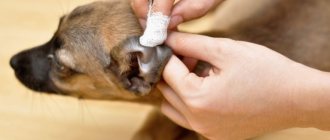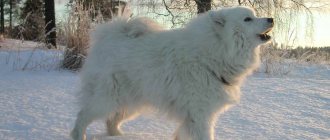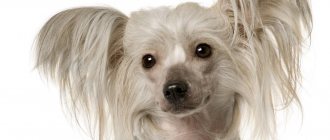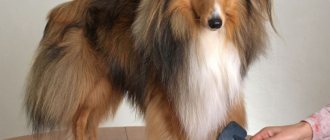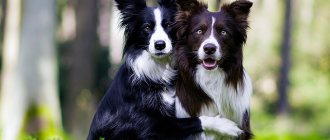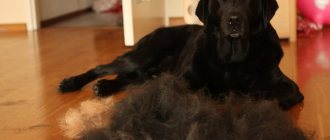Dog grooming equipment
There are quite a lot of different products that can keep your pet’s fur in perfect shape: these are combs, slickers, tangle cutters, combs, etc.
The most common tools, of course, are combs. But, of course, we are talking about special tools suitable for wool, and certain requirements are imposed on them:
- Any pet comb should have blunt teeth, otherwise it can damage the skin. You can check its safety on yourself by running the teeth over your palm; if the teeth catch the skin or an unpleasant sensation appears, then such a tool is not suitable.
- You should choose a tool that has teeth shorter than your pet's fur.
- It is recommended to purchase at least two combs - for initial processing (removing tangles, untangling matted areas) and final processing.
- A comb-comb, the teeth of which are very frequent (the distance between them is 0.5 mm), is intended for combing out parasites. However, if you have a thick coat, it will not be possible to use it for its intended purpose, but it is quite possible to use it during shedding to remove old hair.
If your pet has long, silky hair, then it is better to give preference to a massage brush; for dogs with short hair, a brush with bristles is suitable, in appearance reminiscent of an attribute for cleaning clothes or shoes.
Another important item is a “slicker brush”, which helps to cope with ordinary thick hair. Their working surface is made of metal.
Like combs, slicker brushes should have blunt teeth. You can find similar tools on sale in a variety of sizes, but experts do not recommend purchasing the largest ones. Not only will they not speed up the combing process, but they are also not very convenient to use. For a medium-sized dog, a slicker with sides of 6-7 cm is suitable, for a larger pet - a little larger. When choosing, you should evaluate the strength of the fit of the teeth; they should not dangle freely.
Tangle cutters - this tool allows you to reliably get rid of such troubles as matted tangles. But they do not cut the knots, but unravel them. In fact, this is a great helper for owners of long-haired pets, since almost always when brushing you have to deal with hairballs.
3 types of webbing cutters
The webbing cutters are made from stainless steel. They are equipped with easy-to-use handles. Like other tools, this device is selected based on the size of the pet and the length of its fur.
Scratchers - got this name for their appearance. People call it “rake”. This is one of the most necessary care devices. Here, when choosing, you need to focus on the length of the teeth; the longer the fur, the longer the teeth should be. Brushes are excellent at combing fur, and, in addition, clean the animal’s skin of dead cells and remove old fur during the molting period.
During use, the rake must be held at an angle towards the dog to avoid damaging the skin.
Rubber or silicone gloves and brushes are used to care for smooth-haired dogs that are not burdened with a thick undercoat. They are convenient for getting rid of dead hairs during seasonal molting. For the same purposes, you can use a small piece of suede fabric.
High technologies have affected animal care products, and the Furminator is proof of this. The tool is made of stainless steel, and the plastic handle is equipped with an anti-slip rubber braid. According to studies, up to 90% of old hair can be removed at one time.
The Furminator does not damage the skin or affect new hair and is suitable for almost all breeds, except those that have minimal or no undercoat. The device is very easy to use, just move it without effort in the direction of hair growth.
Types of Dog Grooming Tools
It turns out that there are not so few such tools. All of them are divided according to the purpose of use:
- for combing wool;
- to remove fleas;
- for cutting.
There are the following options for combing wool:
Outwardly, they resemble a razor for men, but a little larger and instead of a blade, it is equipped with several strong iron teeth. It is very convenient to use, it is reliable, and most importantly, dogs love to brush themselves with this tool. The main function of the furminator is to remove dying undercoat, so this tool is not suitable for dogs without it. Furminators are sold in different sizes and with different teeth, which should be chosen based on the length of the dog's coat and its size. The tool itself must be washed after each combing.
REFERENCE! This device has many advantages, but it also has a disadvantage, which is its high cost.
In essence, this device is an analogue of the previous one, but not as perfect. The slicker comb for dogs is different in that it is only suitable for dogs with abundant undercoat due to the fact that it has long iron teeth. Short-haired dogs will find it unpleasant to brush with it. The undoubted advantage of the powder brush is its low cost, accessible to everyone.
When choosing this device, you need to take into account the size of the animal, the abundance and length of hair and the length of the teeth. Also, pay attention to the presence of balls on the tips of the teeth, so as not to hurt the dog when combing.
This item is needed to give the coat a well-groomed appearance after using the slicker. In addition, the comb smoothes the hair of dogs with thick hair, such as Tira Huskies, Samoyeds, Spitz, and so on. Using a comb, you can remove the resulting tangles.
When buying a comb, it is better to choose a double-sided one, so that on one side the teeth have one length and on the other another. This is necessary so that it can be used for combing both the undercoat and fur. A double-sided dog comb is quite reasonably priced.
- Massage brush
There are different options for brushes on sale - with a handle or a hand strap, with natural or artificial bristles. If you choose a brush with metal bristles, you need to have balls on the ends for the dog’s safety. The main task of the brush is to style the pet's fur, combined with skin massage.
REFERENCE! A massage comb is not used for dogs with long hair, as they have a thick undercoat that it is unlikely to cope with.
- Mitten
Outwardly, it really looks like a mitten, with short teeth located on the inside. These mittens are not suitable for long hair, but they are suitable for short and smooth hair. This device is very easy to use because you just need to stroke your pet in the direction of the fur. Both the owner and the dog like this procedure.
This is a tool in which the teeth are fixed freely and can rotate, effectively cleaning out fluff. A dog comb with rotating teeth is not suitable for dogs without undercoat, as hair can get caught on them and cause discomfort to the dog. It is best to use a rake comb for dogs with a thick undercoat.
Combing different types of fur
There are six types of dog hair in nature, so it is important to know what type your pet is in order to care for it correctly:
- The wool is "regular". It has medium length and thickness. Its owners include many breeds, for example, huskies, Labradors, German shepherds, Spitz. The coat is double - long and hard on the outside, soft and shorter on the inside (undercoat). Like other breeds, these dogs shed twice a year and during this period it is necessary to brush the dogs as often as possible to help get rid of dead hair. The rest of the time, combing is done no more than 2-3 times a week.
- Non-shedding hard coat. Nature has decreed that these breeds have lost the ability to change their coat. But it is still necessary to help them get rid of the old cover, however, combing out will not help here. This is where plucking and trimming takes place. This procedure is necessary for terriers, schnauzers, wire-haired terriers and some other representatives of rare breeds.
- The wool is “smooth”. Despite their scant coat, dogs of short-haired breeds can shed intensively, and removing their hair from carpets and furniture is very difficult. They are combed out with special rubber brushes, but a slicker brush is not useful in this case. This type of care is suitable for dachshunds, Dobermans, Dalmatians, Rottweilers, bulldogs, etc.
- The coat is “curly” and non-shedding. Poodles and some types of terriers have it. The main care product, in this case, is a haircut. Combing is, of course, also done, especially often during the molting period. A slicker brush or a brush with a wire surface is used.
- The wool is “long”. The breeds that wear it are quite impressive and always attract attention - these are Afghan hounds, Briards, setters, long-haired collies and shelties, spaniels, etc. To make the coat look well-groomed, it is necessary to comb it daily with a wide-toothed comb. The advantage of such dogs is that their rich undercoat is suitable for yarn and knitting warm clothes, medical belts, which some pet owners enjoy using.
- Atypical coat. If you are lucky enough to become the owner of a pet of an exotic breed with a unique coat, for example, twisted like a strand, like a bullet, then in this case it is unlikely that you will be able to figure out on your own what to do with the dog’s fur. Consulting a breeder or specialist in this matter will help.
General recommendations for grooming dogs
Needless to say, almost all dog breeds can be combed, except for a few exotic ones. This is not only bringing the dog into proper shape, but also a hygienic procedure that removes insects that have penetrated the fur, including parasitic ones, and removes old hairs, dirt and dust. And, in addition, this is an excellent massage of the skin, improving subcutaneous blood circulation.
In order for the dog to calmly tolerate combing its fur, it should be introduced to this activity as early as possible. Moreover, many breeds require coat care from an early puppy age. In order not to scare away the animal, it is necessary to use suitable tools, then the dog will feel a minimum of discomfort, and after the event you should not skimp on affection, kind words and, of course, treats.
Here are some recommendations on how to make the procedure as fruitful as possible:
- You need to start the procedure with a wide-toothed comb (this does not apply to animals with short hair).
- In long-haired dogs or breeds with long hair, it is important to pay special attention to certain areas of the body: the ears (applies to spaniels and setters), the muzzle (schnauzers, lapdogs), the hind legs, where the hair forms the so-called pants, and the tail.
- After combing, it is recommended to use a special brush, moving it in the direction of hair growth. You need to start from the head, move the brush along the back, treating the sides and ending on the paws.
- The slicker is most often used for dogs with a normal coat type, but for long-haired dogs it is better not to use this tool.
If brushing your pet seems unattractive and you don’t feel like doing the procedure yourself or don’t have the time, then you can turn to a specialist groomer for help. Armed with a special tool, he is able to tidy up even the most neglected wool.
In addition, a specialist will be able to help if the dog has gotten into thorns, correct the consequences of an unsuccessful haircut and, most importantly, prepare the pet for an important event in a short time.
What is a furminator for dogs and why is it needed?
People comb their hair every day, and pets need similar care. It is not difficult to accustom a dog to brushing; the main thing is to start the learning process from the first months. No matter how long your pet’s fur is, grooming is a must. Each owner chooses a furminator, slicker brush or comb to suit their taste, the main thing is that it does not injure the animal’s skin and copes with its main purpose.
The process of combing itself has a double meaning. This is a hygienic and preventative care that not only improves the appearance of the pet, but also helps it get rid of debris, parasites, dust and dead particles of skin and fur. In addition, you get a high-quality massage that stimulates blood flow, restoring the hair structure, quality and thickness.
In order to accustom your dog to combing, follow the step-by-step method:
- Long-haired breeds are first combed with a wide-tooth comb, removing particularly tangled areas by hand.
- For spaniels and setters, the ears, hind legs and tail are treated first. There they have the longest hair, which gets very tangled. For lapdogs and schnauzers, grooming begins on the face.
- Having completed the preliminary combing, use a special brush to stroke the fur in the direction from nose to tail.
- Slicker brushes can only be used for pets with medium-length fur. For long-haired or smooth-haired breeds, grooming will turn into torture for the owner and dog.
- If the first attempts to tidy up the animal’s skin are unsuccessful, contact a specialist - a groomer.
Carefully consistent training of the puppy in grooming procedures will help in the future. It is important not to scare your pet or cause him pain during the first attempts to tidy up his fur coat.
The Furminator is a comprehensive tool that includes functions for caring for hair during the shedding period. Can be used daily for preventive purposes.
Also read about how to trim your dog's hair at home.
Furminator (comb) for dogs: a way to forget about the “charms” of shedding
Wool is a pet's decoration and protection. But during the molting period, a beautiful fur coat becomes a headache for the owner. Experienced dog breeders have a variety of combs with large, sparse, and fine teeth in their arsenal to combat falling hair. One of the successful developments is the furminator. Before you make a purchase, you should understand how to use a furminator for dogs and why you should choose this tool.
To prevent grooming from turning into torture for the owner and pet, Angie Porter, a professional groomer, has developed a special comb for combing dogs. Angie's goal was to painlessly reduce the amount of hair shedding without resorting to trimming. Later, the company FURminator (from the English word fur - fur) was created, producing combs for different types of wool.
Who is recommended for combing with a furminator?
As it becomes clear from the purpose of the tool, it is needed by animals with thick undercoat. The spine may not be thick or long - it doesn’t matter. The Furminator for dogs “works” only with the undercoat.
These dogs include long-haired shepherd dogs - German, Eastern European, Central Asian, Caucasian, South Russian, Belgian; northern dogs - huskies, malamutes, samoyeds, akitas, huskies; spaniels; setters; schnauzers; retrievers; griffins; bobtails; St. Bernards. It is recommended to carry out preventive treatment once a month, and during the molting period - more often, as necessary. Proper treatment does not harm your pet's health; on the contrary, it promotes the growth of high-quality fur and improved appearance.
Currently reading:
- Tips for proper dog burial
- Games to choose for training a dog
- Is it worth it or not to include natural food in your dog’s diet?
- The American Cocker Spaniel is an adroit hunter and loyal friend.
What it is
Furminator is a tool with a sharpened, replaceable blade designed to remove undercoat during shedding. Externally, the comb resembles a frequent rake through which the spine passes. This is the main difference between the Furminator and other combs that remove loose hairs, but do not affect the deep undercoat.
Furminators vary in blade width and tooth length. According to size, there are three types of tools.
- Small . It is also called toy (toy). Small models with a working surface width of up to 3-5 cm. The Furminator is designed for small breeds of dogs (Spitz, Dachshund, Pekingese, Welsh Corgi), cats, guinea pigs, and decorative rabbits.
- Average . The blade width is 6-9 cm. The tool is purchased by owners of medium breeds - border collie, cocker spaniel, chow chow, basset hound.
- Big . Convenient furminator for brushing large dogs, such as Akita Inu, Malamute, Shepherd, Setter, Giant Schnauzer. Covers large areas, reducing maintenance time. The blade width is 11-14 cm.
Furminator for dogs: how to use
Dogs' coat is renewed all year round, but this is especially noticeable in the off-season - during the molting period. To prevent your home from becoming overgrown with dog hair, it is recommended to brush your pet once a month. If the dog sheds a lot of hair, go through it with a comb once or twice a week, depending on its length and the pet’s patience.
The instructions for using the tool are simple and do not require special skills. However, some features should be taken into account when combing short-haired and long-haired pets.
Shorthair
Dogs with short hair are combed in four stages.
- Bathing. Wash your dirty pet to prevent the blade from becoming clogged with dust.
- Drying. Dry your dog completely with towels or a hairdryer.
- Stand. Position your pet to reach all areas of the body.
- Combing. Move the Furminator from head to tail, from the sides to the belly and paws.
Longhair
The Furminator for long-haired dogs is used on clean, non-matted hair. First of all, you need to get rid of tangles, if any. This can be done by moistening the wool with shampoo and sorting it out with your hands or simply cutting it. Afterwards, bathe and dry the dog.
Unlike short-haired dogs, long-haired pets are combed in layers along the growth of the hairs. Leave the bottom layer on the belly and lift the rest of the fur with your hand. Comb from chest to tail. Then drop some wool and repeat the procedure. The last layer falls on the back along the spine - from head to tail. Depending on the size of the dog and the neglect of its appearance, the process takes from 15 to 60 minutes.
When not to use a furminator
You cannot use this miracle device if:
- the dog's fur is matted;
- there are tangles;
- there are wounds, bites, abrasions, postoperative unhealed stitches on the body;
- The dog has no undercoat or it is weakly expressed.
Such animals include almost all lapdogs, poodles, Mexican Hairless and Chinese Crested dogs, Papillons, Shih Tzu, Lhasa Apso, terriers - Yorkshire, Wheaten, Bedlington. The Furminator is also not suitable for dogs with hair curled into cords or tangles - commanders, Bergamasco shepherds.
The Furminator is not suitable for smooth-haired dogs, because they have almost no undercoat and combing the dogs will not be effective. The Furminator for short-haired dogs should only be used if their undercoat cannot be removed using a hard mitt.
If a dog has not been accustomed to brushing since childhood, it may actively resist the procedure or become very frightened. If any hygiene procedure is very stressful for her, then it is better not to shake the animal’s psyche through coercion, but to invite a professional groomer. He uses light sedatives in his work and, while she sleeps, processes her fur and puts the animal in order. You should not rely on the fact that the fur will come out on its own and leave the dog alone: since excess unshedded undercoat creates inconvenience for both the animal itself and its owners.
How to choose
Furminator is produced by German, French, and Chinese companies. Each manufacturer is trying to improve a simple tool. On sale you can find furminators with two working surfaces or with a self-cleaning button. Often, buyers purchase an unreliable fake that can harm their pet. Therefore, you should carefully inspect the instrument before purchasing. Three signs will help you choose a quality Furminator for dogs.
- Material. The blade must be made of durable steel. The material resists impacts, does not rust and does not electrify wool. A comb with a metal body lasts longer than its plastic counterpart.
- Teeth. The frequent teeth are located at the same level and have no gaps, roughness or nicks. They hold firmly, and after long use the teeth do not break or bend. At the ends, the teeth are necessarily rounded.
- Pen . It should fit well in the palm, be quite voluminous and rubberized. Choose models with a light handle so as not to get tired during the procedure.
A furminator dog comb will help get rid of hair and save time. After use, rinse the instrument and dry it. Do not wipe the blade with a towel or napkin to avoid dulling the teeth. Keep sealed. Avoid hitting or dropping the tool.
How not to run into a fake
Furminator for dogs (from the English fur - fur) is a common noun. The device received its name from the American company that first launched it on the pet products market - Furminator Inc. Products from this manufacturer are individually packaged and have a special branded holographic sign.
The company locates its production in China. Therefore, a mark that the product was made in China does not indicate that they are trying to sell you a fake.
A similar product is produced by a German manufacturer under the Trixie brand. This comb is often called a grooming trimmer. The grooming attachment of such models can be easily removed for washing under running water and snapped back onto the handle.
Reviews: “This is a magical thing”
We bought a small furminator for 800 rubles, it really combs out the undercoat very effectively without pulling out excess hair, but due to its small size (there was simply no big one), we have to spend a lot of time on hairstyle. So if you buy, take the big one. It’s really a cool thing, we combed more out of just one paw with a furminator than out of the entire dog with a regular slicker brush)) But for some reason several teeth fell off from the edge of it, although this didn’t seem to affect the quality.
I bought it in England at Crafts. Inexpensive (23 pounds) with one blade, and 12-three interchangeable blades. During molting, it works great. But in everyday life you just can’t comb a dog with it, the hair pulls, and groomers say that it causes damage. But during molting, he has no equal. The amount of hair in the house decreases tenfold, with the same vacuuming schedule. My husband managed to pull out Lina’s thighs down to the skin, only now they have grown back (they “glowed” for a couple of months). So everything is good in moderation, this applies to the use of the furminator, first of all.
How to properly comb a dog?
Combing is one of the components of hygienic care for the external integument of the dog. During this procedure, dead hairs, various foreign objects and parasites are removed from the fur. Dogs especially often need brushing during shedding. With the help of simple tools you can help your pet change his hair faster and with less discomfort. Also, brushing your dog will allow you to spend less energy cleaning the house.
You often need to brush your dog after a walk: dust, as well as leaves, dirt, branches and thorns can get into your pet’s fur. During combing, the animal's skin is massaged, resulting in improved blood circulation, and natural fatty lubricant is more evenly distributed throughout the coat.
Advantages
According to numerous reviews from pet owners, breeders and professional groomers, this useful device has more advantages than disadvantages.
Advantages of the Furminator over similar grooming tools:
- quickly and painlessly removes dead undercoat hairs without affecting the outer coat and guard hairs;
- accelerates the animal’s molting process by up to 90%;
- regular combing of the coat helps prevent the appearance of tangles and matting of the hair;
- treatment of strands with a furminator ensures uniform distribution of sebum along the entire length of the animal’s coat;
- in the process of combing out the undercoat, the blood supply to the animal’s skin improves;
- Proper processing of wool does not injure the skin and does not disturb the structure of the hairs of the coat.
The Furminator greatly facilitates the care of your pet's coat during shedding periods and throughout the year.
How often should you brush your dog?
Dogs of different breeds have different needs for brushing their fur. Most representatives of short-haired dog breeds need to be brushed approximately once every two weeks, a little more often is possible, but less often is not advisable. Those with both short and coarse hair can be brushed once every three weeks. Long-haired pets are the most difficult to care for: you need to brush their fur almost every day.
During shedding, your dog needs to be brushed much more often. Smooth-haired dogs need grooming every couple of days, while long-haired dogs need grooming every day. Each breed may have its own standards of care, so the owner must always consult with specialists.
How to brush your dog?
Dog grooming tools are selected for a specific coat type. For example, to brush pets with long and medium hair, you need to use a brush with metal teeth. For pets with very thick soft hair, you need to purchase a slicker brush. This tool allows you to clean thick undercoat.
Complete grooming of short-haired dog breeds is usually possible even with the use of a brush with rubber teeth, such as comb gloves. This tool not only allows you to remove the shortest hairs, but also perfectly massages your pet’s skin.
If you take care of several dogs at once that have different coat types, then you should purchase a universal furminator. It allows you to effectively care for both long-haired and short-haired breeds. You can prevent mats from forming in dogs with thick coats by using a long-toothed comb.
Brushing the dog correctly
There are a number of universal rules that apply to almost all dog breeds, we list the main ones:
- the wool should be combed in the direction of growth;
- you need to start from the head, and then gradually move towards the tail;
- it is advisable to comb all areas of the body, even if the hair in certain places is insignificant;
- You need to massage your pet’s skin and hair using a mitten with elastic teeth once a week;
- You should not comb a dog with a lot of tangles;
- stubborn tangles cannot be untangled by force; this problem can be solved with the help of special shampoos, including dry ones.
Combing procedure
The dog needs to be put down, seated or stood. Her body position changes as the furminator advances. You need to start combing carefully, without tugging or scratching the skin, moving your hand in the direction of hair growth. Particular care should be taken to comb the area under the tail, the belly and the inside of the hind legs. The dog can twist and pull out, since these places are highly sensitive to him. The rest of the dog's body is more willing to be brushed.
Animals with not very long hair need to be combed from top to bottom. A long-haired dog is combed “in layers”, from bottom to top, moving higher only when the entire row below is combed. After getting used to working with the tool and if the dog does not resist, the fluffiest pet can be combed out in 20-30 minutes.
They associate a quick treatment of a dog with a pleasant massage; over time, they willingly approach and stand calmly throughout the entire procedure. At the end of work, the furminator for dogs should be carefully washed with warm soapy water. You cannot use abrasives, wet wipes, or sponges for cleaning, as this will dull the blades.
How to teach a dog to brush?
Brushing is an integral part of caring for your dog. You can completely avoid this responsibility only if you have a “bald” pet. Therefore, the issue of accustoming the dog to this procedure is very important. Practice shows that with the right approach to raising a puppy, problems with combing almost never arise. The ideal age for accustoming to combing is considered to be from one to three months.
While the pet gets used to the procedure, it is necessary to handle its fur and skin very delicately. Any pain can be remembered for a long time by the puppy and he will have the wrong idea about combing. Adult animals also need to be trained gradually and carefully. An excellent motivation for your pet to endure the procedure is subsequent feeding with tasty treats.
Sources:
https://dogipedia.ru/kak-i-chem-vychesyvat-sherst-u-sobaki/ https://pitomec.guru/sobaki/uhod/furminator/ https://royal-groom.ru/vychesyvanie-sobak

